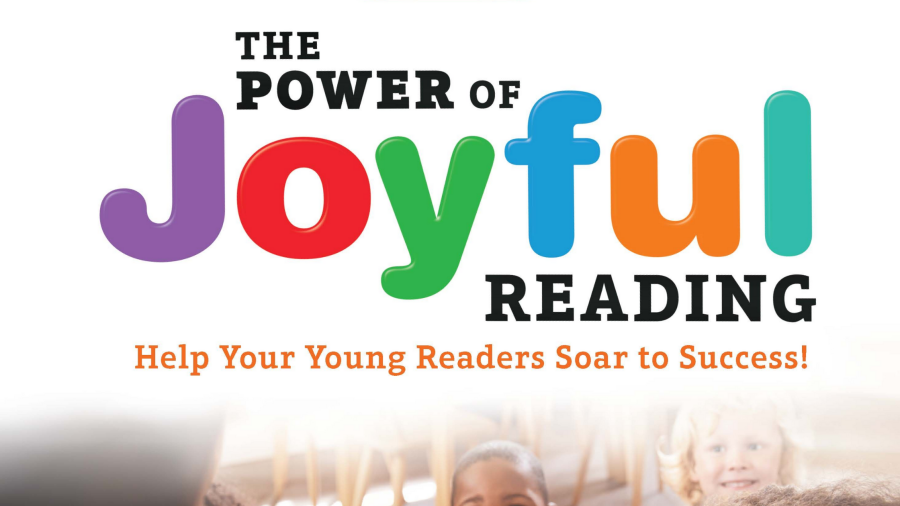
Best-selling children’s author, Eric Litwin and co-author Dr. Gina Pepin share their thoughts about the impact of joyful reading with parents and educators in their new professional text, The Power of Joyful Reading: Help Your Young Readers Soar to Success! Using the acronym HERO, they “spell out” very clearly how to make sure children learn to love reading just as much as they learn how to read.
Happiness increases learning. It turns out that when positive learning experiences create joy, there is a chemical reaction in our brains that increases memory, focus, and our capacity for problem-solving. Co-founder of the NeuroLeadership Institute, David Rock says, “Interest, happiness, joy, and desire are approach emotions. This state is one of increased dopamine levels, important for interest and learning.”
Litwin and Pepin agree that joyfulness and reading need to go together in order to increase engagement and learning. This book delightfully provides ways in which to weave joyful and engaging reading experiences into every aspect of an early childhood classroom, because strengthening fundamental skills and knowledge of reading is easier if children love to do it!
Litwin and Pepin (2020) outline four essential elements to creating joyful reading experiences for young children:
Human
Human beings are unique and social, so our reading instruction must be, as well. Children learn through meaningful interactions and so, when it comes to reading and writing, nothing can fully replace a cherished teacher reading and writing with children in authentic ways. Litwin and Pepin lay out easy techniques to create a “Reading Playground” in your classroom that will immerse students in print while simultaneously celebrating each reader’s uniqueness.
Experiential
Learning happens best when students are immersed in the process. Litwin and Pepin lay out simple, multisensory participation techniques throughout their book to make your classroom experiences highly experiential. If you have been following our study of the book, Made for Learning: How the Conditions of Learning Guide Teaching Decisions, then you know that Debra Crouch (2020) and Brian Cambourne agree and identify immersion as a crucial Condition for Learning. They say, “They hear and attempt not only words but also the sounds, rhythms, and cadences of language they are learning.”
Recurring
“Learning is more likely to happen and be remembered when the same or similar experience happens many times a day, day after day, all year long, especially when it comes to young children (Litwin & Pepin, 2020).” Litwin and Pepin explain that you can make joyful reading experiences happen anytime, anywhere in your day simply by putting text and rhythm to everyday tasks, such as reviewing classroom expectations, making lunch choices, or getting ready to go home. When joyful experiences recur, it’s fun, and fun leads to engagement and learning.
Optimal
Designing reading experiences that are optimal for literacy development is essential so that every moment is full of learning potential. This requires that the experiences we create must be “guided by your firm knowledge of how children learn to read, which enables you to focus and adapt…to meet the needs of your students (Litwin & Pepin, 2020).” Litwin and Pepin provide many ways to incorporate phonemic awareness and the alphabetic principle into authentic and fun reading experiences throughout the day, but they note that teacher expertise is not only warranted, but necessary. Building one’s own knowledge of reading development is crucial, and each chapter contains resources that support and extend their ideas.
A Call to Action
The Power of Joyful Reading is a call to action for teachers to examine their practices to ensure that children develop a love of reading as they learn how to read. To remember that the true outcome of literacy development is to create readers who want to read. Litwin, a former third-grade teacher, acknowledges that many of his former reluctant readers may not have had a strong reading foundation, and that by the time they reached his classroom, they had lost the love of reading. This can be changed, Litwin and Pepin, propose, by using the Joyful Reading Approach laid out in their newest text. This approach, they say, can work “harmoniously with purposeful reading and writing activities and research informed direct instruction.”
Within the conflict of how to teach reading, I fear that we have lost the joy, or perhaps made joy the secondary goal, sending the message that joy in reading is what you experience after you learn to do it. But joy can be experienced at every stage and step. To prevent children from giving up on finding joy in reading, please do explore Litwin and Pepin’s new book, The Power of Joyful Reading: Help Your Young Readers Soar to Success! for a variety of ways to infuse any curriculum with joyful reading experiences.

Another good read! You two continue to inspire! Martha
Sent from my iPad
>
LikeLiked by 1 person